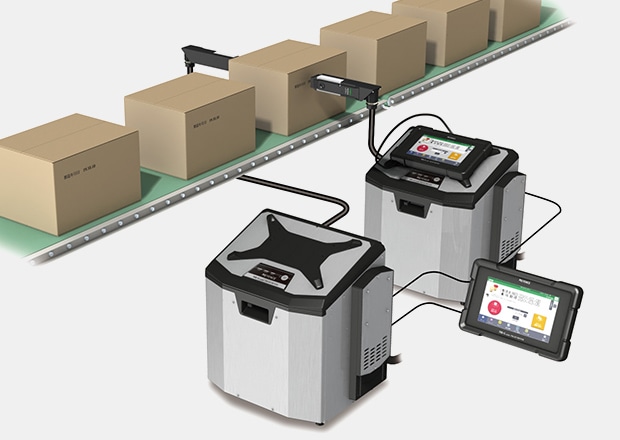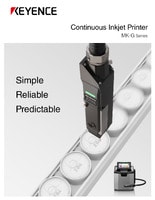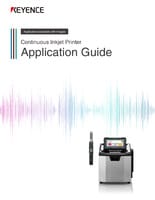Continuous Inkjet Printers / Case Coder
Inkjet Printer for Boxes - Food, Chemical and Cosmetics Industries
A continuous inkjet printer is widely used for printing date/lot codes on primary packaging which is required by industry standards. Due to many advantages CIJ has over other coding technologies such as print speed, print durability, cost per print, and usability in various substrates; CIJ is often a preferred solution for printing on secondary packagings.
Secondary packaging is what the individual primary packaged goods are shipped in. An example of this is chip bags packed in cardboard boxes, or trayed PET bottles held in shrink wrap. The codes on these boxes normally contain product tracking information such as batch codes and case quantity rather than information needed at point-of-purchase.
Secondary Packaging Printing Applications
Application
Printing best by dates and lot numbers on cardboard boxes, wrapping paper, and other packaging.
Advantages
Easy to install on a case sealer. The ability to adjust character spacing as desired ensures smooth checking with print inspection systems.
Cardboard Box Printing/Installation Example

Printing example

Installation example
Installation Example: Dual-Side Printing on Cardboard Boxes

Dual-side printing can be performed by the inkjet printer for products that require printing on both sides. Changing print content for both sides simultaneously is easy and can be done using just a single touchscreen.
When compared to roller-type stamping machines, inkjet printers offer clearer printing with no missing or faded characters. The ability to adjust throw distance, which is not available with on-demand types, eliminates damages that could have occurred from the print head coming into contact with cardboard.
Solutions Provided
- Printing expiration dates, best by dates, lot numbers, and more
- Customizable character spacing
- Inspect printing using a print inspection machine
Curious about our pricing?
Click here to find out more.

Importance of Date Code Printing on Cardboard Boxes
Date code printing, also called date coding, involves printing important product information—particularly when the product was manufactured, packaged, or should be used or sold. This practice is most commonly associated with the food and beverage industries, but it’s also present in the chemical and cosmetics industries, as well.
Date printing is important as it conveys crucial product-related information vital for consumer and manufacturer traceability. For example, date coding on perishable goods helps consumers determine the freshness of the product, while the batch or lot number, which is also a part of date coding, helps manufacturers identify defective product batches and lots.
It’s also important to note that coding transcends practical reasons alone; it’s also mandated by many governing bodies that regulate specific industries, particularly when it comes to perishable goods.
We’re here to provide you with more details.
Reach out today!

Challenges in Date and Serial Code Printing on Cardboard Boxes
Most challenges in date and serial code printing on cardboard boxes are associated with the properties of cardboard as a printing substrate. Cardboard surfaces are uneven, porous, and textured, which affects print quality. Additionally, the porous surface means the cardboard absorbs ink faster than other materials or smooth surfaces.
This can potentially lead to printing issues, such as blurred or smudged prints, especially if the ink doesn’t dry quickly enough. Another issue is the high-speed production lines in which boxes are often printed and packaged together in quick succession.
Fortunately, KEYENCE’s MK-G Series continuous inkjet printer for boxes solves these issues. The printer doesn’t make any physical contact with the substrate; instead, it shoots pressurized, fast-drying ink droplets onto the substrate to form an image or text—in this case, date code.
Continuous inkjet printers for boxes also resolve the issue of fast-moving production lines since modern models have the ability to print up to 1,000 meters of single-line text per minute.
Get detailed information on our products by downloading our catalog.
View Catalog

Applications of Cardboard Box Printing
For many products, regulations dictate that certain information must be printed on the packaging. This includes ingredients, nutritional information, instructions, expiration dates, and even safety warnings.
However, inkjet printing for boxes isn’t limited to date codes alone. It can also be used to print company logos, product names, and other branding elements associated with the brand directly onto the cardboard packaging.
Discover more about this product.
Click here to book your demo.

Improved Tracking and Traceability Through Printing on Cardboard Boxes
There’s also a matter of tracking and traceability, with inkjet printers for boxes being used to print batch codes and barcodes. These enable more efficient tracking throughout the supply chain, as well as more efficient inventory management. Other codes might include product authentication verification details that can further increase the transparency of the overall supply chain.
Looking to improve your cardboard printing? KEYENCE’s MK-G Series continuous inkjet printer is the world’s best self-diagnosing and self-troubleshooting printer. With the Smart Startup, the printer will automatically display the device status and choose the appropriate cleaning method with minimal solvent use and only when required, reducing operational costs and exposure to chemicals. A user-friendly maintenance guide will help even inexperienced personnel navigate unexpected errors by following the illustrations on the console. Contact KEYENCE today.
Get detailed information on our products by downloading our catalog.
View Catalog

Related Downloads

This guide explains continuous inkjet (CIJ) printer applications together with pictures and illustrations. It contains many installation examples in various industries divided into food, medicine, and cosmetics; electrical machinery and electronics; and automotive, metal, and others. These examples show printing on targets specific to each industry.


![Process-specific Marking Applications [Food/Pharmaceutical Industry]](/img/asset/AS_133442_L.jpg)

